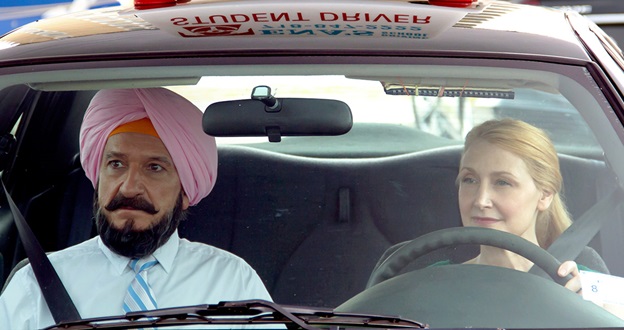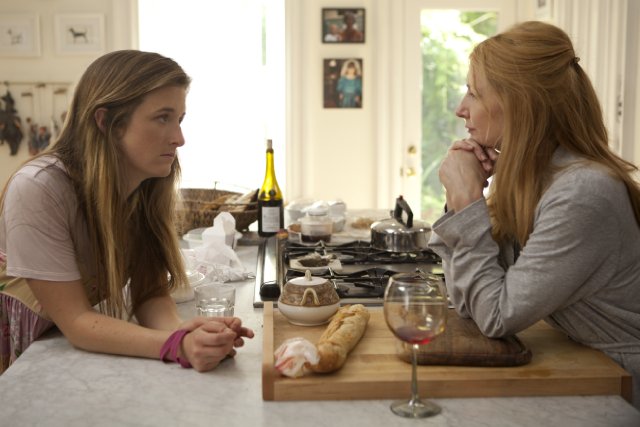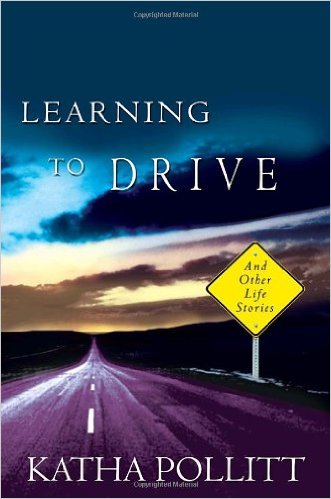 “Learning to Drive,” about a middle-aged Sikh driving instructor and his middle-aged student, is a satisfyingly grownup movie. Its stakes are gentle but real. Its characters behave decently yet feel strongly, and their parallel worlds are unfair if occasionally joyous. For this reason but not this reason alone, this is a late-summer film to see, despite its pedestrian premise. (Puns are an occupational hazard when discussing this topic.)
“Learning to Drive,” about a middle-aged Sikh driving instructor and his middle-aged student, is a satisfyingly grownup movie. Its stakes are gentle but real. Its characters behave decently yet feel strongly, and their parallel worlds are unfair if occasionally joyous. For this reason but not this reason alone, this is a late-summer film to see, despite its pedestrian premise. (Puns are an occupational hazard when discussing this topic.)
The luminous Patricia Clarkson is rock-star book critic Wendy, whose enviable NYC intelligentsia lifestyle is in tatters since Ted (Jake Weber), her relatively unsuccessful husband, left her for a colleague, and her daughter, Tasha (Grace Gummer), took off for a remote Vermont commune. A lifelong city kid, Wendy realizes she’s going to have to learn to drive if she’s ever going to see Tasha again, so she enlists the services of Darwan (Ben Kingsley), an overworked Indian immigrant who drives a taxi by night and teaches driving by day.
This is an unusually female project from its conception to its execution. It is adapted from an essay about – you guessed it – learning to drive, penned by feminist poet, political writer, and author Katha Pollitt after her own marriage dissolved. (You can read it in her eponymously titled collection of essays.) Producer Dana Friedman knew the story required a conflict to successfully transition to screen, so she hired Sarah Kernochan – who, implausibly enough, wrote both “9½ Weeks” and the stiff-upper-lip period drama “Impromptu” – to pull an actual screenplay out of it. From there, the two women showed it to Patricia Clarkson, who to her credit is always seeking projects featuring complex grownup ladies, and Clarkson enlisted Kingsley and Spanish director Isabel Coixet, who had directed both actors in the (too-prettily) rueful “Eulogy.”  Lest anyone take “Aloha”-style umbrage about Kingsley playing a Sikh (that is, lest anyone not have seen “Gandhi”), it should be established that his father was of Gujarati Indian descent and that he and Kernochan researched the Queens, New York, Sikh community so meticulously that “Learning to Drive” is rife with striking details about its modes of worship, domestic arrangements, and, most importantly, code of honor.
Lest anyone take “Aloha”-style umbrage about Kingsley playing a Sikh (that is, lest anyone not have seen “Gandhi”), it should be established that his father was of Gujarati Indian descent and that he and Kernochan researched the Queens, New York, Sikh community so meticulously that “Learning to Drive” is rife with striking details about its modes of worship, domestic arrangements, and, most importantly, code of honor.
Honor is the name of the game here. As hurt and overwhelmed as these protagonists are, they strive to be decent – to be true and kind, to atone when they behave badly, to hold themselves and the world to the high standards that they believe are necessary for civilized living. Though Kingsley is as starchy as ever (he plays all his characters as saintly, which usually renders them insufferable), this works for Darwan, whose self-possession helps him transcend the humiliations he faces daily in a post-9/11 New York. And there’s a reason Clarkson became more well-known when she was already middle aged: She radiates a combination of delight and gravitas that is impossible to imagine in an ingénue. It is also what makes you want to spend as much time as possible with her even when she’s portraying a character like Wendy, who is elitist in the particular manner of people anxious to shed their working-class backgrounds. (It emerges that Wendy knows Queens better than she lets on.)
In a different movie, Wendy and Darwan might fall in love. Here they develop a careful, courtly friendship as she white-knuckles wine glasses and the steering wheel (not simultaneously) and he settles into an arranged marriage with fresh-off-the-boat Jasleen (Sarita Choudhury), whose unhappy confusion enlivens the third act. The trio’s progression is engrossing rather than stressful because we come to trust them as they come to trust each other; it’s an experience that is surprisingly rare in American cinema. Coixet’s direction helps, as does the editing of Thelma Schoonmaker, best known for her work on Martin Scorsese’s films.  Though car scenes can be visually dull, the city flashes by in a lovely, unfussy stream that puts everyone’s troubles into constant perspective.
Though car scenes can be visually dull, the city flashes by in a lovely, unfussy stream that puts everyone’s troubles into constant perspective.
This is a tale about adulthood and disappointment that treats time as a friend rather than a foe. The weeks and months glide by in another sort of stream, slowly healing these scarred, sympathetic people by easing their burdens with a grave tenderness. The metaphors of learning to drive may be simple (even simplistic) – that we must live with our eyes wide open, that we must tackle experiences head-on, that we must look behind us even as we move forward – but they are elegantly, usefully presented.
This was originally published in Word and Film.
